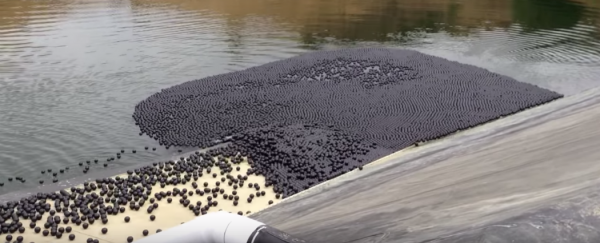This is one of those stories that doesn't make a lot of sense until you've heard the science behind it: earlier this week the mayor of LA Eric Garcetti helped to dump 20,000 small black plastic balls into the city's reservoir. It marks the final phase of a the innovative project, in which a total of 96 million balls have been poured into the 175-acre man-made lake.
The reason? These 'shade balls', as they're known, are actually very effective at keeping water clean and protecting it from evaporation - an issue that those living in Los Angeles and the rest of California are only too aware of right now. Each ball is weighed down with a little water, they're cheap (costing just 36 cents per unit), and they can last for 10 years before they need to be replaced.
Although the LA Department of Water and Power is the first utility company to use shade balls to protect its water, the little orbs themselves aren't a new invention. In the past they've been used to keep birds away from water tanks at airports and prevent water evaporation at oil and gas sites.
And the primary reason for deploying the hollow balls is more to protect the quality of the water rather than to simply stop it evaporating. In the reservoir water, the naturally occurring bromide was mixing with sunlight and chlorine (added to disinfect drinking water) to create dangerous levels of the the carcinogen bromate. Shade balls should stop that harmful chemical reaction from happening at a large scale.
"In the midst of California's historic drought, it takes bold ingenuity to maximise my goals for water conservation," said Mayor Eric Garcetti in a statement. "This effort by LADWP is emblematic of the kind of the creative thinking we need to meet those challenges. Together, we've led the charge to cut our city's water usage by 13 percent, and today we complete an infrastructure investment that saves our ratepayers millions and protects a vital source of drinking water for years to come."
So why are the balls a light-absorbing black colour, rather than a light-reflecting white? They're coated in carbon black, a nearly-pure elemental carbon often used in car tyres - the blackness of the shade balls completely blocks and absorbs sunlight, preventing any of it from getting through to the water. As far as thin plastics like these are concerned, a white colouring would create a translucent ball: some light would be reflected away but some would get through to the water below.
It's estimated that some 300 million gallons of water a year can be saved with the shade balls. That's not a massive figure compared with the 13.6 billion gallons of water LA residents worked their way through in June, but it's something, even if it does give the top of the reservoir a rather eerie and alien-like sheen. Among the other drought-fighting measures in the pipeline is a plan to pull water from the Pacific Ocean.
